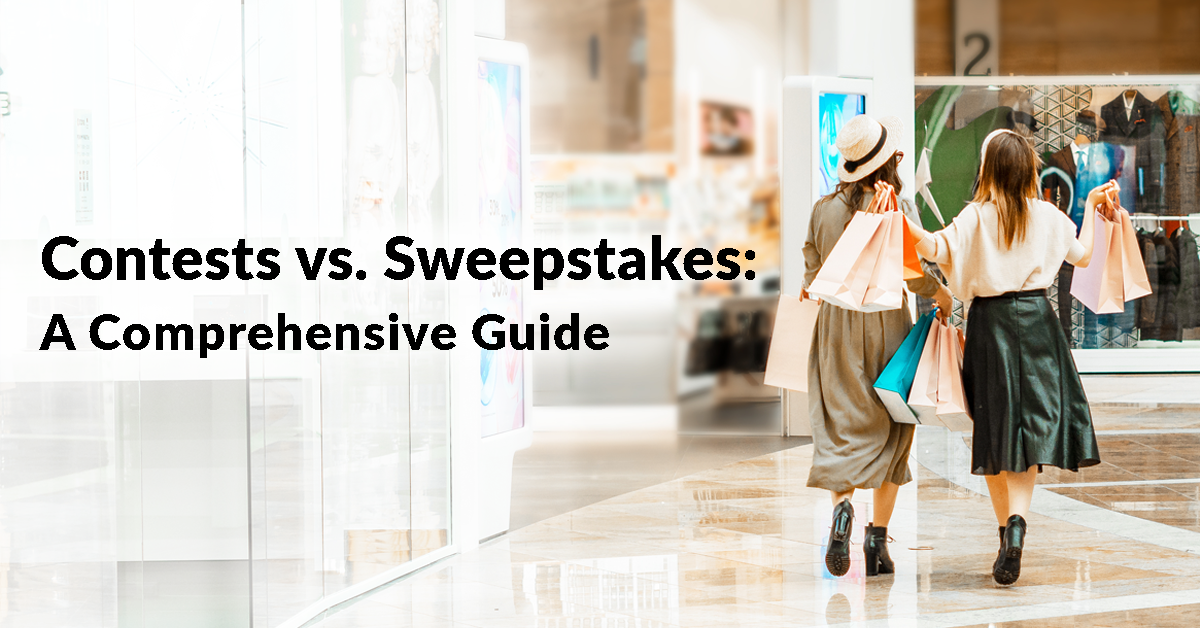Contests or Sweepstakes - Which One Should You Choose?
When to Choose a Contest
Choose a contest if you want to encourage deeper engagement and interactions. Contests require some type of content submission (often user-generated content), which means that participants have to make a concentrated effort to create content to win prizes or to be entered. Because they require effort from the participants, the consumers who participate often have some level of loyalty to the brand. Contests can even help create a community of engaged users genuinely interested in the brand and its products.
It's also interesting that brands that use user-generated content find it one of the best ways to engage customers and prospective customers and build brand awareness. A recent study found that 82% of consumers are more inclined to purchase a brand's products if it incorporates user-generated content into its marketing initiatives. When you design a contest so that the submissions align with the brand's values and messaging, you gain access to user-generated content that supports the brand.
Another important reason to choose a contest over a sweepstakes is what you plan to do with the information about the participants. If you want to create a list of high-quality leads, then run a contest. If you want to learn more about your customers or prospective customers, a contest can provide valuable insights (when done correctly), including information on interests and preferences that can help you tailor future campaigns.
Keep in mind that all contests and sweepstakes require rules and guidelines that make it clear how the contest is conducted from start to finish and what rights a brand has for any user-generated content submitted during the contest. There are also local, federal, and state laws related to contest and sweepstakes that brands must adhere to.
When to Choose a Sweepstakes
Depending on your goals, you can also gain a lot of value running sweepstakes. Sweepstakes are a great tactic if your goal is to generate brand awareness, build a larger marketing list, or to reach a broader audience than your typical customers. Sweepstakes are much easier for consumers to enter because they require little effort to participate. As a result, sweepstakes can generate a lot of buzz and excitement and attract a much larger number of participants.
For brands looking to acquire new customers, sweepstakes can attract individuals who might have yet to interact with the brand. Offering a desirable prize can entice people to learn more about the brand.
Sweepstakes are also much easier to set up and run than contests, which makes them perfect for running quick marketing campaigns for a short period, such as event- or holiday campaigns or promotions of a new product. They can quickly generate a list of contacts marketers can use for future campaigns.
Sweepstakes are also more straightforward to regulate and manage legally than contests. However, they have their share of legal requirements, including the no-purchase-necessary rule and risk of promotion fraud (more on this later).
Getting Started with Contests or Sweepstakes
Once you've considered the options and decided which promotional strategy you want to run. It's time to make a plan, and we have a list of things you need to consider as you put that plan together. Contests and sweepstakes share many similarities in how they are organized and planned. We'll discuss the process for both and point out any unique areas for each promotion type.
Define Objectives & Identify the Target Audience
First, it’s important to define your goals and objectives. Why are you conducting the contest or sweepstakes, and what do you want to gain from it? Do you want to generate brand awareness or engagement? Do you want to collect a list of contacts (leads) or user-generated content?
You should also outline how you plan to measure the success of your promotion. What metrics do you want to achieve? The number of submissions or emails is an example of metrics to track.
Who is the audience you want to attract to your promotion? Are you focusing on customers or trying to reach a new target demographic? Detail the target audience as much as possible. This information will help you tailor the promotion to their interests and behaviors.
Set a Budget and Select Prizes
Set a budget for your promotion. The budget should include costs for prizes, marketing activities (email, social media, advertising, marketing resources), platforms or technologies that help you manage the promotion, and any legal fees.
You must also identify the prizes you will offer in your promotion to motivate consumers to participate. Prizes are similar across contests and promotions—cash rewards, gift certificates, products, and experiences such as trips or tickets to big events are common. The prize you select should be relevant to the audience you want to reach and within your budget.
Establish Rules and Guidelines
First, set a timeline for the entire promotion. What is the start and end date? How will participants enter the contest or sweepstakes? When will the judging take place (contest), or an entry be drawn (sweepstakes)? How are winners announced?
Draft clear and detailed rules that cover eligibility, entry methods, deadlines, judging criteria (for contests), winner selection, and prize distribution. Ensure that any details related to compliance with local, state, and federal laws are described and any social media platform rules.
Identify Legal and Ethical Considerations
Compliance with all local, state, and federal laws related to conducting contests and sweepstakes is critical. Depending on where you plan to run the promotion, those laws and regulations will differ, so it's essential to familiarize yourself with them (and have a tool and legal team to help).
Be sure to:
- Clearly define terms and conditions and make them readily available on the contest or sweepstakes website, including rules and regulations, entry methods, deadlines, eligibility criteria, prize descriptions, and any restrictions (e.g., age, geography, etc).
- Register your sweepstakes with any required government agency (bonding and registration), disclosing all relevant details. For example, Florida and New York require you to register and bond any prize pool over US $5,000.
- Identify any social network rules, including showing disclaimers and having influencers mark posts as “sponsored.”
- Provide an AMOE (alternate method of entry) if you require a consideration to enter a sweepstakes (such as a purchase). An AMOE, such as an email or mail-in entry, enables participants to enter the sweepstakes without purchase. You also need to ensure that all entries are treated equally regardless of how they were obtained.
- Have a clear privacy policy that describes what information you are collecting and how you will use it. Ensure participants can request that you delete their personal information after the contest or sweepstakes if they want to.
Promotion fraud is another important legal consideration. Promotion fraud refers to dishonest activities and tactics individuals or groups use to exploit contests and sweepstakes for personal gain. These can include submitting false entries (using fake emails or names), using bots (to flood the contest with entries), or using proxy servers to disguise IP addresses, making it difficult to enforce geographic restrictions or detect multiple entries from the same individual.
To ensure the fairness of the contest or sweepstakes, it's important to mitigate promotion fraud. There are a few ways you can do this, including using entry validation (e.g., CAPTCHA, photo markers, date and time stamps, requiring email verification), restricting entry based on IP addresses, applying statistical analysis to flag outliers in participation rates, random audits, education, and more.
Marketing Planning and Promotion
With the basic planning out of the way, it’s time to think about marketing your contest or sweepstakes. The first thing to do is create a compelling theme for the promotion that aligns with your brand and resonates with the target audience. The theme will guide all your marketing campaign activities.
If you are running a contest, identify the brand values and messages you want the contest entries to consider, and adapt your contest entry rules to indicate that contest entries should consider these messages.
Every promotion needs a website or landing page where you share information on the contest or sweepstakes and provide all the promotion details, including how to enter, prizes to win, and all rules and regulations.
To promote your contest or sweepstakes, there are different channels you can use and relationships you can leverage, including:
- Social Media Platforms — Promote contests and sweepstakes on all your social media platforms using eye-catching visuals and hashtags. Briefly explain the rules and point to a website for more detailed information.
- Influencers — Work with influencers to get them to promote the contest or sweepstakes to their followers. Identify influencers whose audience fits the target audience you defined for the promotion.
- Partnerships — Collaborate with other brands or websites to promote the contest or sweepstakes.
- Email Marketing and Newsletters — Create an email campaign that tells your existing customers and leads about the contest or sweepstakes and gives them reasons to participate. Mention the promotion in your newsletter to encourage readers to submit an entry or share the contest with their friends or colleagues.
- Advertising — Promote your contest using both traditional and digital advertising channels. Traditional channels, like TV or radio ads, should only be used if the promotion is longer term, primarily because of their costs.
- Pop-up Ads — Set up pop-up ads on your website that tell visitors about the promotion and drive them to your contest landing page to get more information. If it's a sweepstakes, capture their contact information directly in the pop-up form. Just be sure to provide links to detailed information on the sweepstakes rules and regulations.
Select the Right Platforms and Tools
Managing a promotion is a lot easier when you have tools to help. We've already mentioned that you need a website or landing page and social media channels. But you also need tools to help you manage the contest or sweepstake itself.
Contest and sweepstakes management software can give you all the tools you need to manage your promotion from start to finish. This software provides tools for setting up the promotion, including all legal and compliance requirements, collecting and verifying entries, supporting multiple submission channels, and offering prize procurement and fulfillment, among other capabilities.
Track Performance During and After
As your contest or sweepstakes is running, monitor performance and look for ways to adjust your marketing activities to gain more attention and capture more entries. When the promotion is completed, analyze its performance against the objectives you identified in the planning process. Some of the metrics you can capture at the end of your promotion include:
For Contests- Number of entries and engagement rate.
- Quality and reach of user-generated content.
- Impact on brand loyalty and sales.
- Total number of entries and new leads.
- Conversion rate and ROI.
- Impact on brand awareness and reach.
You can also request feedback from participants on how they perceived the contest. The data and insights you capture will help you improve your next contest or sweepstakes.
Future Trends to Consider
Future trends in contests and sweepstakes have the potential to transform how brands engage with their audiences. Gamification, which incorporates game-like elements to make promotions more engaging and rewarding, is already impacting sweepstakes and driving higher participation and loyalty (Starbucks is a good example of gamification). AR (Augmented Reality) and VR (Virtual Reality) are other techniques that create more immersive and interactive contest experiences, although these may see slower adoption.
Additionally, ethical marketing and sustainability considerations are gaining attention, with brands focusing on transparent practices, eco-friendly prizes, and socially responsible themes to resonate with conscientious consumers.
On the management side, the integration of AI and automation will streamline the management of these promotions, from detecting fraud to personalizing participant experiences, ensuring more efficient and secure campaigns.
Ready to Get Started with Your New Contest or Sweepstakes?
Contests and sweepstakes are effective marketing tools for engaging consumers, boosting brand awareness, and fostering customer loyalty, but they serve different purposes. Contests require participants to demonstrate skill or creativity, leading to deep engagement and valuable user-generated content. Sweepstakes rely on chance, attracting a broader audience with minimal participant effort, making them ideal for quickly expanding brand reach.
We explored the distinctions between the two types of promotions and the benefits, challenges, and best practices for effectively implementing each. We hope this guide has given you the information you need to proceed with your next promotion.
To learn how Snipp, can help your company with contests, sweepstakes or other types of promotions, contact us here for a short consultation.











